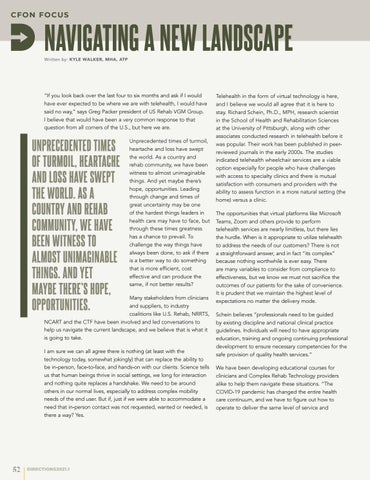CFON FO CU S
NAVIGATING A NEW LANDSCAPE Written by: KYLE WALKER, MHA, ATP
“If you look back over the last four to six months and ask if I would have ever expected to be where we are with telehealth, I would have said no way,” says Greg Packer president of US Rehab VGM Group. I believe that would have been a very common response to that question from all corners of the U.S., but here we are.
UNPRECEDENTED TIMES OF TURMOIL, HEARTACHE AND LOSS HAVE SWEPT THE WORLD. AS A COUNTRY AND REHAB COMMUNITY, WE HAVE BEEN WITNESS TO ALMOST UNIMAGINABLE THINGS. AND YET MAYBE THERE’S HOPE, OPPORTUNITIES.
Unprecedented times of turmoil, heartache and loss have swept the world. As a country and rehab community, we have been witness to almost unimaginable things. And yet maybe there’s hope, opportunities. Leading through change and times of great uncertainty may be one of the hardest things leaders in health care may have to face, but through these times greatness has a chance to prevail. To challenge the way things have always been done, to ask if there is a better way to do something that is more efficient, cost effective and can produce the same, if not better results?
Many stakeholders from clinicians and suppliers, to industry coalitions like U.S. Rehab, NRRTS, NCART and the CTF have been involved and led conversations to help us navigate the current landscape, and we believe that is what it is going to take. I am sure we can all agree there is nothing (at least with the technology today, somewhat jokingly) that can replace the ability to be in-person, face-to-face, and hands-on with our clients. Science tells us that human beings thrive in social settings, we long for interaction and nothing quite replaces a handshake. We need to be around others in our normal lives, especially to address complex mobility needs of the end user. But if, just if we were able to accommodate a need that in-person contact was not requested, wanted or needed, is there a way? Yes.
52
DIRECTIONS 2021.1
Telehealth in the form of virtual technology is here, and I believe we would all agree that it is here to stay. Richard Schein, Ph.D., MPH, research scientist in the School of Health and Rehabilitation Sciences at the University of Pittsburgh, along with other associates conducted research in telehealth before it was popular. Their work has been published in peerreviewed journals in the early 2000s. The studies indicated telehealth wheelchair services are a viable option especially for people who have challenges with access to specialty clinics and there is mutual satisfaction with consumers and providers with the ability to assess function in a more natural setting (the home) versus a clinic. The opportunities that virtual platforms like Microsoft Teams, Zoom and others provide to perform telehealth services are nearly limitless, but there lies the hurdle. When is it appropriate to utilize telehealth to address the needs of our customers? There is not a straightforward answer, and in fact “its complex” because nothing worthwhile is ever easy. There are many variables to consider from compliance to effectiveness, but we know we must not sacrifice the outcomes of our patients for the sake of convenience. It is prudent that we maintain the highest level of expectations no matter the delivery mode. Schein believes “professionals need to be guided by existing discipline and national clinical practice guidelines. Individuals will need to have appropriate education, training and ongoing continuing professional development to ensure necessary competencies for the safe provision of quality health services.” We have been developing educational courses for clinicians and Complex Rehab Technology providers alike to help them navigate these situations. “The COVID-19 pandemic has changed the entire health care continuum, and we have to figure out how to operate to deliver the same level of service and









